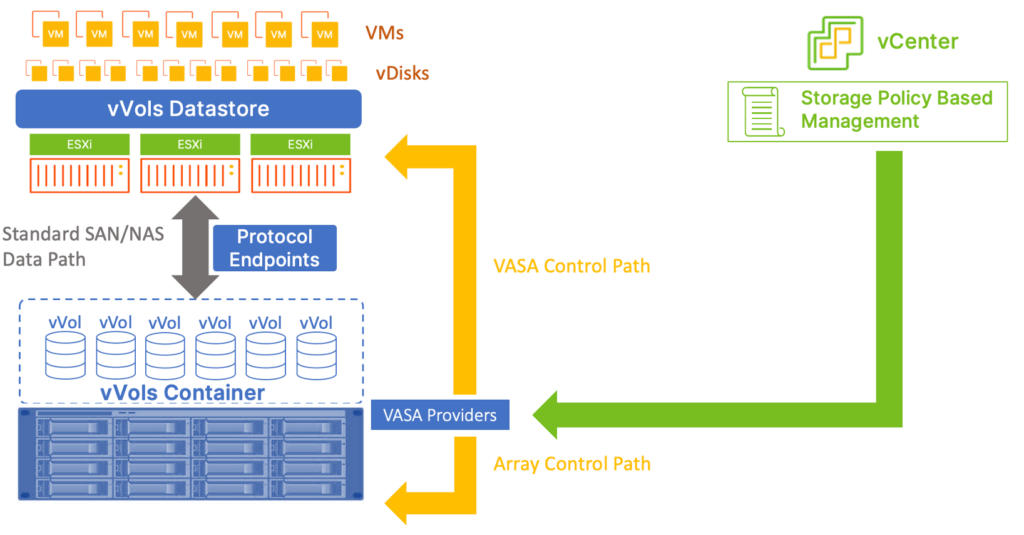Remember when those of use in the VDI space used to joke around about “this is the year of the desktop!”? Well, for the last 10 months I’ve been very busy talking about vVols in a variety of forums. It is a wildly popular topic and i’m seeing a surge in adoption (shoutout to my awesome customers and partners!) So – why are vVols a hot topic right now?
Let’s realize some value of a core vSphere feature
Development of vVols started back in 2011 and was announced at VMWorld in 2013. vVols were then shipped with vSphere 6.0 in 2015. This vSphere-Land post provides a very nice overview of the history of vVols – https://tinyurl.com/bdza3tbu

So…for the last 8 years, vVols have been part of the core SDDC stack. The Storage Policy Based Management (SPBM) policy engine has been a mainstream feature in vSphere for a significant amount of time. Numerous best-in-class storage and data protection solutions now support vVols. We can’t consider vVols to be a fringe or nouveau feature any longer. So, now in 2023, doesn’t it make sense to deploy the powerful capabilities in this core feature? Let’s talk about some of the features that are especially relevant today.
vVols Technology has matured
Let’s face it – when vVols were first launched, things were a little rough around the edges. Scale and performance were a problem. Solutions integrations were sparse. And there weren’t a lot of platforms that supported vVols.
In 2023, things have evolved. The performance/scale/resiliency attributes in vSphere (especially in vSphere 8u1) are very refined. Many of the core innovations in vSphere 8 are focused on vVols and the roadmap looks amazing. There are numerous great storage platforms out there that support vVols. Lots of amazing backup solutions are vVols ready. And most industry-leading monitoring/reporting solutions support vVols.
Efficiency through Automation
I talk to numerous IT organizations every week and I consistently hear that teams are interested in automation as a means to add efficiency to routine operations. vVols and SPBM offer built-in SDDC automation where you can easily and flexibly apply data service policies to VMs and even individual disks. This means that you can create and enforce consistent SLAs easily, AND you can rely on vSphere policy enforcement to keep things tight. Changing data services policies (to adapt to a changing set of of business requirements) is as easy as applying a new SPBM policy! And if SPBM can’t do it, it is easy to leverage PowerCLI and REST API to operationalize your blueprints.

Operational Rigor and Consistency
From accurate workload placement to consistent policy-based assignment of data protection services, vVols SPBM can lead to more consistent services that can lead to greater consistency and uniformity of services. This leads to a consistent SDDC foundation and better shot at true intrinsic security. Entropy and sloppiness in storage service configurations can make it harder to spot data service policy violations. An application server that is classified as production could be better protected from malware attacks if a “snapshot locally every hour” policy is enforced. And SPBM and vVols make this easy!

Silos as barriers
The divide between storage and virtualization teams is much less today. In the good old days, there was a organizational fence between storage and virtualization teams. These days I’m seeing fewer and fewer operational silos between storage and virtualization teams. The operational aspects of vVols shift the way that storage capacity is consumed and the way that data services policies are assigned. Virtualization ops teams are put in direct control of many functions that were the responsibility of the storage teams in the VMFS age. As IT organizations become less specialized, it is far easier for vVols to be introduced without causing tension and angst in IT camps and silos.

Increased efficiency at scale
With vVols we can enjoy better efficiency in allocating capacity with vVols (provision required vDisk capacity and not a bunch of VMFS overhead). It is not uncommon to see a 10 to 15% reduction in capacity consumption when the same workload is moved from VMFS to vVols. I see this routinely when working with small and large customers.
The performance benefits of vVols can also be significant. with storage provider based snapshots is huge. This VMware whitepaper provides weighty arguments in favor of vVols based storage if virtual machine snapshots are employed – https://tinyurl.com/2adjn4eu The comparison graphs that show VMFS versus vVols performance when vVols are present is eye-opening! Other performance benefits can come from thinks like vDisk level QoS policies, where IO or throughput limits can be set and enforced. What a great way to reduce noisy neighbor issues!

Telemetry and metrics
This is one of things that I find the most compelling about vVols in 2023. I love me some data and vVols lets us derive performance and capacity insights at a VM and vDisk level of granularity. With VMFS, we can’t easily see back-end performance and capacity utilization statistics or trends when tens or hundreds of VMs are deployed on a shared datastore. Since vVols operate as individual volumes, we get to enjoy more granular views of storage stats. And with modern data services platforms like Pure Storage, we present these statistics right in the vSphere Web Client via our plugin integration. This means that an operator doesn’t need to access a backend storage interface to consume these stats – they are right there in the vCenter UI and available via REST API as well!

Summary
So, why are we still talking about vVols in 2023?

The efficiency, automation, and telemetry benefits that come with vVols help us more easily adopt a cloud operating model. In the same way that large service providers and public clouds operate efficiently, consistently, and securely – modern IT organizations desire the same operational capabilities. vVols have matured and are now considered as a core vSphere feature. It’s a great time to take ‘em for a spin!

